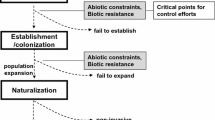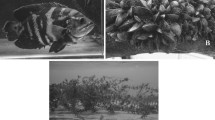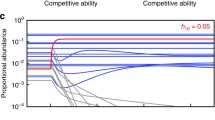Abstract
Although the predatory and competitive impacts of biological invasions are well documented, facilitation of native species by non-indigenous species is frequently overlooked. A search through recent ecological literature found that facilitative interactions between invasive and native species occur in a wide range of habitats, can have cascading effects across trophic levels, can re-structure communities, and can lead to evolutionary changes. These are critical findings that, until now, have been mostly absent from analyses of ecological impacts of biological invasions. Here I present evidence for several mechanisms that exemplify how exotic species can facilitate native species. These mechanisms include habitat modification, trophic subsidy, pollination, competitive release, and predatory release. Habitat modification is the most frequently documented mechanism, reflecting the drastic changes generated by the invasion of functionally novel habitat engineers. Further, I predict that facilitative impacts on native species will be most likely when invasive species provide a limiting resource, increase habitat complexity, functionally replace a native species, or ameliorate predation or competition. Finally, three types of facilitation (novel, substitutive, and indirect) define why exotic species can lead to facilitation of native species. It is evident that understanding biological invasions at the community and ecosystem levels will be more accurate if we integrate facilitative interactions into future ecological research. Since facilitative impacts of biological invasions can occur with native endangered species, and can have wide-ranging impacts, these results also have important implications for management, eradication, and restoration.
Similar content being viewed by others
References
TR Angradi, SM Hagan and KW Able, Vegetation type and the intertidal macroinvertebrate fauna of a brackish marsh: phragmites vs Spartina. Wetlands 21 (2001) 75-92
R Arsenault and N Owen-Smith, Facilitation versus competition in grazing herbivore assemblages. Oikos 97 (2002) 313-318
DP Batzer, CR Pusateri and R Vetter, Impacts of fish predation on marsh invertebrates: direct and indirect effects. Wetlands 20 (2000) 307-312
MD Bertness and GH Leonard, The role of positive interactions in communities: lessons from intertidal habitats. Ecology 78 (1997) 1976-1989
MD Bertness, GH Leonard, JM Levine, PR Schmidt and AO Ingraham, Testing the relative contribution of positive and negative interactions in rocky intertidal communities. Ecology 80 (1999) 2711-2726
A Bially and HJ MacIsaac, Fouling mussels (Dreissena spp.) colonize soft sediments in Lake Erie and facilitate benthic invertebrates. Freshwater Biology 43 (2000) 85-97
BJF Biggs, SN Francoeur, AD Huryn, R Young, CJ Arbuckle and CR Townsend, Trophic cascades in streams: effects of nutrient enrichment on autotrophic and consumer benthic communities under two different fish predation regimes. Canadian Journal of Fisheries and Aquatic Sciences 57 (2000) 1380-1394
RW Braithwaite, WM Lonsdale and JA Estbergs, Alien vegetation and native biota in tropical Australia: the impact of Mimosa pigra. Biological Conservation 48 (1989) 189-210
JF Bruno and CW Kennedy, Patch-size dependent habitat modification and facilitation on new england cobble beaches by spartina alterniflora. Oecologia (Berlin) 122 (2000) 98-108
JF Bruno, JJ Stachowicz and MD Bertness, Inclusion of facilitation into ecological theory. Trends in Ecology & Evolution 18 (2003) 119-125
JF Bruno, JD Fridley, KD Bromberg and MD Bertness, Insights into biotic interactions from studies of species invasions. In: DF Sax, JJ Stachowicz and SD Gaines (eds.) Species Invasions: Insights into Ecology, Evolution, and Biogeography. Sunderland, Massachusetts: Sinauer Associates (2005) pp. 13-40
GC Cadee, Herring gulls learn to feed on a recent invader in the Dutch Wadden Sea, the Pacific oyster Crassostrea gigas. Basteria 65 (2001) 33-42
RM Callaway and LR Walker, Competition and facilitation: a synthetic approach to interactions in plant communities. Ecology 78 (1997) 1958-1965
JT Carlton, Man’s role in changing the face of the ocean biological invasions and implications for conservation of near-shore environments. Conservation Biology 3 (1989) 265-273
JC Castilla, NA Lagos and M Cerda, Marine ecosystem engineering by the alien ascidian Pyura praeputialis on a mid-intertidal rochy shore. Marine Ecology Progress Series 268 (2004) 119-130
FE Clements, Nature and structure of the climax. Journal of Ecology 24 (1936) 252-284
FC Coleman and SL Williams, Overexploiting marine ecosystem engineers: potential consequences for biodiversity. Trends in Ecology & Evolution 17 (2002) 40-44
PA Cox, Extinction of the Hawaiian avifauna resulted in a change of pollinators for the ieie, Freycinetia arborea. Oikos 41 (1983) 195-199
JA Crooks, Habitat alteration and community-level effects of an exotic mussel, Musculista senhousia. Marine Ecology Progress Series 162 (1998) 137-152
JA Crooks, Characterizing ecosystem-level consequences of biological invasions: the role of ecosystem engineers. Oikos 97 (2002) 153-166
JA Crooks and HS Khim, Architectural vs biological effects of a habitat-altering, exotic mussel, Musculista senhousia. Journal of Experimental Marine Biology and Ecology 240 (1999) 53-75
J Crooks and ME Soulé, Lag times in population explosions of invasive species: causes and implications. In: OT Sandlund, SJ Schei and A Vikens (eds.) Invasive Species and Biodiversity Management. The Netherlands: Kluwer Academic Publishers (1999) pp. 103-125
MR Crossland, Direct and indirect effects of the introduced toad Bufo marinus (Anura: Bufonidae) on populations of native anuran larvae in Australia. Ecography 23 (2000) 283-290
C D’Antonio and LA Meyerson, Exotic plant species as problems and solutions in ecological restoration: a synthesis. Restoration Ecology 10 (2002) 703-713
G Darrigran, Potential impact of filter-feeding invaders on temperate inland freshwater environments. Biological Invasions 4 (2002) 145-156
JTA Dick, Post-invasion amphipod communities of lough neagh, northern ireland: influences of habitat selection and mutual predation. Journal of Animal Ecology 65 (1996) 756-767
KC Duffy and DM Baltz, Comparison of fish assemblages associated with native and exotic submerged macrophytes in the lake pontchartrain estuary, USA. Journal of Experimental Marine Biology and Ecology 223 (1998) 199-221
CS Elton, The ecology of invasions by animals and plants. Chicago: The University of Chicago Press (1958).
DE Goldberg, T Rajaniemi, J Gurevitch and A Stewart-Oaten, Empirical approaches to quantifying interaction intensity: competition and facilitation along productivity gradients. Ecology 80 (1999) 1118-1131
SD Graves and AM Shapiro, Exotics as host plants of the California butterfly fauna. Biological Conservation 110 (2003) 413-433
E Grosholz, Ecological and evolutionary consequences of coastal invasions. Trends in Ecology & Evolution 17 (2002) 22-27
ED Grosholz, Recent biological invasion may hasten invasional meltdown by accelerating historical introductions. PNAS 102 (2005) 1088-1091
ED Grosholz, GM Ruiz, CA Dean, KA Shirley, JL Maron and PG Connors, The impacts of a nonindigenous marine predator in a California bay. Ecology 81 (2000) 1206-1224
CL Gross, The effect of introduced honeybees on native bee visitation and fruit-set in dillwynia juniperina (fabaceae) in a fragmented ecosystem. Biological Conservation 102 (2001) 89-95
J Gurevitch and LV Hedges, Meta-analysis: combining the results of independent experiments. In: SM Scheiner and J Gurevitch (eds.) The Design and Analysis of Ecological Experiments. New York and London: Chapman and Hall (2001) pp. 347-369
SD Hacker and SD Gaines, Some implications of direct positive interactions for community species diversity. Ecology 78 (1997) 1990-2003
JM Harding, Predation by blue crabs, Callinectes sapidus, on rapa whelks, Rapana venosa: possible natural controls for an invasive species?. Journal of Experimental Marine Biology and Ecology 297 (2003) 161-177
LV Hedges and I Olkin, Statistical methods for meta-analysis. New York: Academic Press (1985).
MG Holloway and MJ Keough, An introduced polychaete affects recruitment and larval abundance of sessile invertebrates. Ecological Applications 12 (2002) 1803-1823
K Horskins and VB Turner, Resource use and foraging patterns of honeybees, apis mellifera, and native insects on flowers of Eucalyptus costata. Australian Journal of Ecology 24 (1999) 221-227
AD Huryn, Ecosystem-level evidence for top–down and bottom–up control of production in a grassland stream system. Oecologia (Berlin) 115 (1998) 173-183
DH Janzen and PS Martin, Neotropical anachronisms: the fruits the gomphotheres ate. Science 215 (1982) 19-27
LE Johnson and DK Padilla, Geographic spread of exotic species: ecological lessons and opportunities from the invasion of the zebra mussel Dreissena polymorpha. Biological Conservation 78 (1996) 23-33
CG Jones, JH Lawton and M Shachak, Positive and negative effects of organisms as physical ecosystem engineers. Ecology 78 (1997) 1946-1957
PM Kareiva and MD Bertness, Re-examining the role of positive interactions in communities. Ecology 78 (1997) 1945
M Kato, A Shibata, T Yasui and H Nagamasu, Impact of introduced honeybees, apis mellifera, upon native bee communities in the bonin (ogasawara) islands. Researches on Population Ecology 41 (1999) 217-228
RA Knapp, KR Matthews and O Sarnelle, Resistance and resilience of alpine lake fauna to fish introductions. Ecological Monographs 71 (2001) 401-421
CL Laxson, KN McPhedran, JC Makarewicz, IV Telesh and HJ MacIsaac, Effects of the non-indigenous cladoceran Cercopagis pengoi on the lower food web of Lake Ontario. Freshwater Biology 48 (2003) 2094-2106
LM Leege and PG Murphy, Ecological effects of the non-native pinus nigra on sand dune communities. Canadian Journal of Botany 79 (2001) 429-437
JM Levine, Indirect facilitation: evidence and predictions from a riparian community. Ecology 80 (1999) 1762-1769
RN Mack, D Simberloff, WM Lonsdale, H Evans, M Clout and FA Bazzaz, Biotic invasions: causes, epidemiology, global consequences, and control. Ecological Applications 10 (2000) 689-710
C MacNeil, NJ Fielding, JTA Dick, M Briffa, J Prenter, MJ Hatcher and AM Dunn, An acanthocephalan parasite mediates intraguild predation between invasive and native freshwater amphipods (Crustacea). Freshwater Biology 48 (2003) 2085-2093
J Memmott, SV Fowler, Q Paynter, AW Sheppard and P Syrett, The invertebrate fauna on broom, Cytisus scoparius, in two native and two exotic habitats. Acta Oecologica 21 (2000) 213-222
J Memmott and NM Waser, Integration of alien plants into a native flower-pollinator visitation web. Proceedings of the Royal Society of London – Series B: Biological Sciences 269 (2002) 2395-2399
BA Menge, Testing the relative importance of positive and negative effects on community structure. Trends in Ecology & Evolution 15 (2000) 46-47
JH Myers, D Simberloff, AM Kuris and JR Carey, Reply from J. Myers, D. Simberloff, A. Kuris and J. Carey. Trends in Ecology & Evolution 15 (2000a) 515-516
JH Myers, D Simberloff, M Kuris Armand and JR Carey, Eradication revisited: dealing with exotic species. Trends in Ecology & Evolution 15 (2000b) 316-320
V Novotny, S Miller, L Cizek, J Leps, M Janda, Y Basset, GD Weiblen and K Karrow, Colonising aliens: caterpillars (Lepidoptera) feeding on Piper aduncum and P.␣umbellatum in rainforests in Papau New Guinea. Ecological Entomology 28 (2003) 704-716
P Nystrom, C Bronmark and W Graneli, Influence of an exotic and a native crayfish species on a littoral benthic community. Oikos 85 (1999) 545-553
YK Ortega, DE Pearson and KS McKelvey, Effects of biological control agents and exotic plant invasion on deer mouse populations. Ecological Applications 14 (2004) 241-253
CW Osenberg, O Sarnelle, SD Cooper and RD Holt, Resolving ecological questions through meta-analysis: goals, metrics, and models. Ecology 80 (1999) 1105-1117
R Otsamo, Secondary forest regeneration under fast-growing forest plantations on degraded Imperata cylindrica grasslands. New Forests 19 (2000) 69-93
DE Pearson and RM Callaway, Indirect effects of host-specific biological control agents. Trends in Ecology & Evolution [print] 18 (2003) 456-461
DE Pearson, KS McKelvey and LF Ruggiero, Non-target effects of an introduced biological control agent on deer mouse ecology. Oecologia (Berlin) 122 (2000) 121-128
MH Posey, Community changes associated with the spread of an introduced seagrass, Zostera japonica. Ecology 69 (1988) 974-983
MH Posey, C Wigland and JC Stevenson, Effects of an introduced aquatic plant, Hydrilla ventricillata, on benthic communities in the upper Chesapeake Bay. Estuarine, Coastal and Shelf Science 37 (1993) 539-555
PM Quinos, P Insausti and A Soriano, Facilitative effect of lotus tenuis on Paspalum dilatatum in a lowland grassland of Argentina. Oecologia (Berlin) 114 (1998) 427-431
TBH Reusch and SL Williams, Variable responses of native eelgrass Zostera marina to a non-indigenous bivalve Musculista senhousia. Oecologia 113 (1998) 428-441
A Ricciardi, Facilitative interactions among aquatic invaders: is an “invasional meltdown” occurring in the great lakes?. Canadian Journal of Fisheries and Aquatic Sciences 58 (2001) 2513-2525
A Ricciardi and S Atkinson, Distinctiveness magnifies the impact of biological invaders in aquatic ecosystems. Ecology Letters 7 (2004) 781-784
A Ricciardi, FG Whoriskey and JB Rasmussen, The role of the zebra mussel (Dreissena polymorpha) in structuring macroinvertebrate communities on hard substrata. Canadian Journal of Fisheries and Aquatic Sciences 54 (1997) 2596-2608
DM Richardson, N Allsopp, CM D’Antonio, SJ Milton and M Rejmanek, Plant invasions: the role of mutualisms. Biological Reviews (Cambridge) 75 (2000) 65-93
GW Roemer, CJ Donlan and F Courchamp, Golden eagles, feral pigs, and insular carnivores: how exotic species turn native predators into prey. Proceedings of the National Academy of Sciences of the United States of America 99 (2002) 791-796
GG Roitman, Pollination biology of Grindelia covasii (asteraceae), a potential crop for arid lands. Journal of Arid Environments 43 (1999) 103-110
GM Ruiz, JT Carlton, ED Grosholz and AH Hines, Global invasions of marine and estuarine habitats by non-indigenous species: mechanisms, extent, and consequences. American Zoologist 37 (1997) 621-632
DF Sax, BP Kinlan and KF Smith, A conceptual framework for comparing species assemblages in native and exotic habitats. Oikos 108 (2005) 457-464
K Schonrogge and MJ Crawley, Quantitative webs as a means of assessing the impact of alien insects. Journal of Animal Ecology 69 (2000) 841-868
ESG Schreiber, PS Lake and GP Quinn, Facilitation of native stream fauna by an invading species? Experimental investigations of the interactions of the snail Potamopyrgus antipodarum (Hydrobiidae) with native benthic fauna. Biological Invasions 4 (2002) 317-325
E Schwindt, A Bortolus and O Iribarne Oscar, Invasion of a reef-builder polychaete: direct and indirect impacts on the native benthic community structure. Biological Invasions 3 (2001) 137-149
AM Shapiro, The Californian urban butterfly fauna is dependent on alien plants. Diversity and Distributions 8 (2002) 31-40
D Simberloff and B Von Holle, Positive interactions of nonindigenous species: invasional meltdown?. Biological Invasions 1 (1999) 21-32
D Simberloff and L Gibbons, Now you see them, now you don’t! – population crashes of established introduced species. Biological Invasions 6 (2004) 161-172
MC Singer, CD Thomas and C Parmesan, Rapid human-induced evolution of insect–host associations. Nature 366 (1993) 681-683
CN Spencer, BR McClelland and JA Stanford, Shrimp stocking, salmon collapse, and eagle displacement: cascading interactions in the food web of a large aquatic ecosystem. BioScience 41 (1991) 14-21
JJ Stachowicz, Mutualism, facilitation, and the structure of ecological communities. BioScience 51 (2001) 235-246
TW Stewart and JM Haynes, Benthic macroinvertebrate communities of southwestern lake ontario following invasion of dreissena. Journal of Great Lakes Research 20 (1994) 479-493
DR Strong, Rapid asymptotic species accumlation in phytophagous insect communities: the pests of Cacao. Science 185 (1974) 1064-1066
DR Strong, Time and the number of herbivore species: the pests of sugarcane. Ecology 58 (1977) 167-175
Thayer SA, Haas RC, Hunter RD and Kushler RH (1996) Positive growth response by adult and juvenile yellow perch in the presence of zebra mussels and the mechanism and magnitude of zebra mussel effects on other zoobenthos in pond exclosures. The 6th International Zebra Mussel and Other Aquatic Nuisance Species Conference, Dearborn, Michigan. Michigan Sea Grant
D Thomson, Competitive displacement between the invasive European honey bee and native bumble bees. Ecology 85 (2004) 458-470
JH Thorp and AF Casper, Potential effects on zooplankton from species shifts in planktivorous mussels: a field experiment in the St Lawrence river. Freshwater Biology 47 (2002) 107-119
CR Townsend, Invasion biology and ecological impacts of brown trout salmo trutta in New zealand. Biological Conservation 78 (1996) 13-22
CD Trowbridge, Emerging associations on marine rocky shores: specialist herbivores on introduced macroalgae. Journal of Animal Ecology 73 (2004) 294-308
P Van Riel, AM Frias Martins and T Beckeljau, Eradication of exotic species. Trends in Ecology & Evolution 15 (2000) 515
GJ Vermeij, An agenda for invasion biology. Biological Conservation 78 (1996) 3-9
PM Vitousek, CM D’Antonio, LL Loope and R Westbrooks, Biological invasions as global environmental change. American Scientist 84 (1996) 468-478
DS Wilcove, D Rothstein, J Dubow, A Phillips and E Losos, Quantifying threats to imperiled species in the United States. BioScience 48 (1998) 607-615
MJ Wonham, M O’Connor and C Harley, Positive effects of a dominant invader on introduced and native mudflat species. Marine Ecology Progress Series 289 (2005) 109-116
JT Wootton, Predicting direct and indirect effects: an integrated approach using experiments and path analysis. Ecology (Tempe) 75 (1994) 151-165
ES Zavaleta, RJ Hobbs and HA Mooney, Viewing invasive species removal in a whole-ecosystem context. Trends in Ecology & Evolution 16 (2001) 454-459
Author information
Authors and Affiliations
Corresponding author
Additional information
Contribution Number 2293, Bodega Marine Laboratory, University of California at Davis.
Rights and permissions
About this article
Cite this article
Rodriguez, L.F. Can Invasive Species Facilitate Native Species? Evidence of How, When, and Why These Impacts Occur. Biol Invasions 8, 927–939 (2006). https://doi.org/10.1007/s10530-005-5103-3
Received:
Accepted:
Published:
Issue Date:
DOI: https://doi.org/10.1007/s10530-005-5103-3




